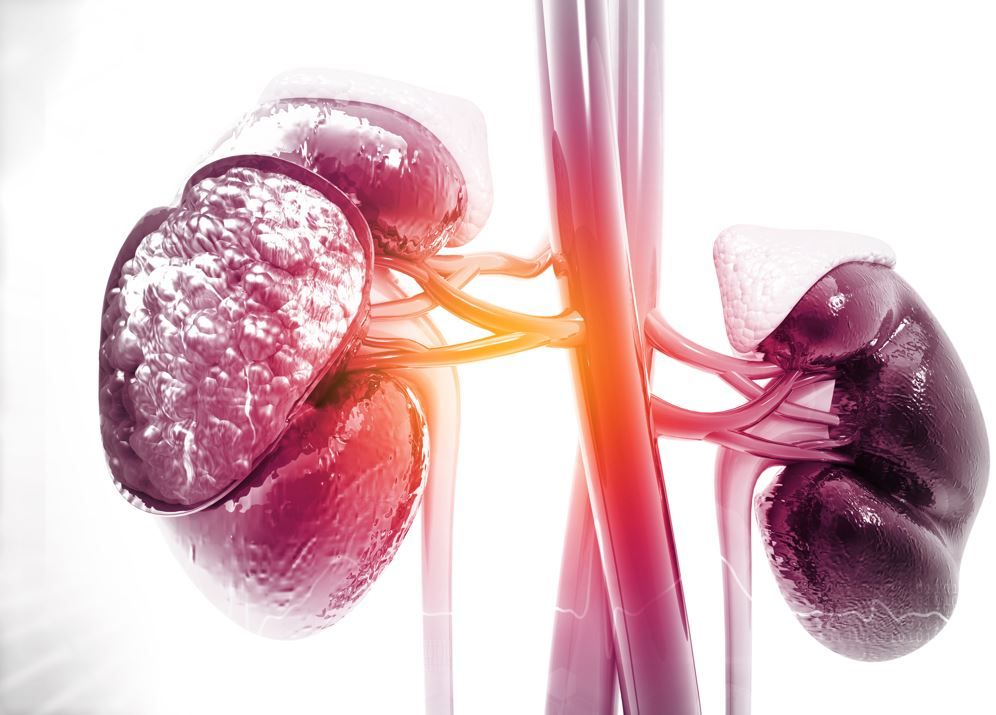- Clinical Technology
- Adult Immunization
- Hepatology
- Pediatric Immunization
- Screening
- Psychiatry
- Allergy
- Women's Health
- Cardiology
- Pediatrics
- Dermatology
- Endocrinology
- Pain Management
- Gastroenterology
- Infectious Disease
- Obesity Medicine
- Rheumatology
- Nephrology
- Neurology
- Pulmonology
Finerenone Reduces CKD-associated Composite Cardiovascular Risk in a New Subanalysis of FIDELITY Trial
Finerenone was associated with a decrease in composite CV risk in patients with CKD, T2D, eGFR of ≥25, and moderately to severely increased albuminuria.

Findings from a subanalysis of the FIDELITY clinical trial suggest that treatment with finerenone may reduce chronic kidney disease (CKD)-associated compositecardiovascular (CV) risk in patients with type 2 diabetes (T2D).
Results showed that finerenone, a nonsteroidal mineralocorticoid receptor antagonist, was associated with a decrease in composite CV risk in patients with CKD, T2D, estimated glomerular filtration rate (eGFR) of ≥25, and moderately to severely increased albuminuria.
“The modifiability of cardiovascular risk among patients with CKD has been demonstrated with the use of simvastatin-ezetimibe in the Study of Heart and Renal Protection (SHARP) trial,” wrote researchers in JAMA Cardiology. “However, the study considered kidney function (as assessed by eGFR) but not kidney damage (albuminuria) in the recruitment strategy. Thus, the modifiability of CKD-associated cardiovascular risk in patients with T2D in a broader population — even with eGFR of 60 or greater and defined by albuminuria — remains unknown.”
“In patients with T2D, we tested whether the cardiovascular disease risk associated with CKD, as defined jointly by eGFR and albuminuria, was modifiable with finerenone treatment. We then estimated the population-wide benefit in the US if all eligible patients were treated with finerenone,” continued first author Rajiv Agarwal, MD, MBBS, MS, professor of medicine at the Indiana University School of Medicine and physician scientist at the Richard L. Roudebush VA Medical Center, and colleagues.
Researchers analyzed data from FIDELITY, a prespecified pooled analysis of results from 2 large phase 3 randomized clinical trials with finerenone, FIDELIO-DKD and FIGARO-DKD, which together examined CV and renal outcomes across a broad spectrum of CKD severity in patients with T2D. Results from FIDELITY showed that finerenone was associated with a 20% lower risk of end-stage kidney disease among patients with T2D and CKD.
Also, in a FIDELITY prespecified analysis of pooled data from both trials, findings demonstrated that reductions seen in risk for CV and renal outcomes in patients with CKD and T2D treated with finerenone were consistentacross baseline A1c, variability in A1c, and duration of T2D.
Agarwal and colleagues combined incidence rates of CV events from FIDELITY with data from the National Health and Nutrition Examination Survey (2015-2016 and 2017-2018) “to simulate the number of composite cardiovascular events that may be prevented per year with finerenone at a population level.”
The primary outcome was a composite of CV outcomes including CV death, nonfatal stroke, nonfatal myocardial infarction, or hospitalization for heart failure (HF) during a median of 3 years by eGFR and albuminuria categories, according to the study.
FINDINGS
A total of 13 026 patients (mean age, 64.8 years; 69.8% men) were included in the current analysis.
Investigators observed that a lower eGFR and higher albuminuria were associated with higher incidences of CV events.
Among participants in the placebo group with an eGFR of ≥90, incident CV event rates per 100 patient-years were 2.38 (95% CI 1.03-4.29) in those with a urine albumin to creatinine ratio (UACR) <300 mg/g and 3.78 (95% CI 2.91-4.75) in those with a UACR of ≥300 mg/g. Among patients with an eGFR of <30, incidence rates increased to 6.54 per 100 patient-years (95% CI 4.19-9.40) in those with a UACR of <300 mg/g and to 8.74 per 100 patient-years (95% CI 6.78-10.93) in those with a UACR of ≥300 mg/g.
Finerenone was associated with a reduction in composite CV risk (hazard ratio [HR] 0.86, 95% CI 0.78-0.95; P=.002) regardless of eGFR and UACR (P for interaction=.66), according to study authors.
When Agarwal and coauthors used nationally representative data from 6.4 million persons eligible for treatment with finerenone, they noted that 1 year of treatment was simulated to prevent 38 359 CV events, including approximately 14 000 hospitalizations for HF, of which 66% could be prevented in patients with albuminuria and eGFR ≥60.
“The observation of an elevated, but modifiable, composite cardiovascular risk in patients with eGFR of 60 or greater but with moderately to severely increased albuminuria has significant implications for clinical practice,” wrote Agarwal et al. “Despite recommendations in guidelines to screen both eGFR and albuminuria at least annually in patients with T2D, real-world evidence indicates that levels of screening for albuminuria in patients with CKD or T2D in clinical practice are very low.”
“Although the importance of albuminuria as a risk factor for cardiovascular events is well known, the findings presented here indicate the ability to modify this risk to reduce morbidity and mortality, highlighting the urgency to improve rates of albuminuria testing irrespective of a patient’s eGFR,” noted researchers.
Reference: Agarwal R, Pitt B, Rossing P, et al. Modifiability of composite cardiovascular risk associated with chronic kidney disease in type 2 diabetes with finerenone. JAMA Cardiol. Published online June 14, 2023. doi:10.1001/jamacardio.2023.1505.
